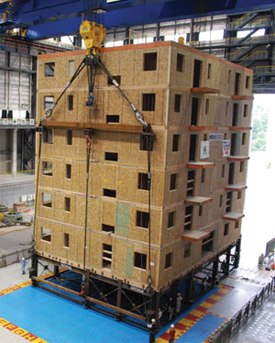Mid-Rise Wood Construction
Differential Movement
Allowing for differential movement between wood and other structural elements and building finishes is critical. Steel, concrete and brick continue to expand and contract due to temperature changes, while wood generally maintains its dimensions having reached its EMC. Differential movement occurs when, for example, floor joists are supported by a wood-frame wall at one end and by the masonry block of an elevator shaft at the other end. Areas such as stairwells, shafts and vaulted ceilings require attention for differential movements as do plumbing, electrical and mechanical systems. Using flexible joints such as flexible pipe, conduit, couplings, elbows, and tees for electrical, mechanical and plumbing between floors can prevent potential problems. The design of the joints between building envelope components, such as windows and doors, must also allow for differential shrinkage.
Seismic Requirements
Earthquakes and rigorous seismic requirements are a well-known aspect of building on the west coast, but other parts of the country, especially in the east, are not immune to earthquake activity and the need to comply with seismic codes. Wood construction provides high strength with relatively low weight, and the high strength-to-weight ratio makes wood a good choice for earthquake-resistant construction.7 In wood-frame buildings, the large number of walls and floors often used in a project transfer lateral loads induced by winds and seismic forces.
Wood-frame construction also provides numerous load paths through shear walls and diaphragms, which typically have hundreds of structural elements and thousands of nail connections, adding ductility and redundancy to the system. Redundant load paths give additional assurance that loads will be transferred should a connection fail. In contrast, structures supported by heavy non-wood frames have relatively few structural members and connections, meaning fewer load paths. Moreover, the large number of walls reduces the loads shared by each wall. Tests and observations from past earthquakes show that wood buildings have performed well. For example, a six-story light-frame wood building tested on the world's largest shake table in Japan resisted a major 2,500-year earthquake with minimal damage.
Current building code requirements for wood diaphragms, shear walls and holdown devices work effectively in creating earthquake-resistive structures. Horizontal diaphragms in roofs and floors transfer the horizontal forces to the shear walls. Shear walls with holdowns such as a continuous tie-down rod system resist the tension forces in an overturning scenario, while wood studs or columns absorb the compression forces.
Wood structural panel shear walls are typically used throughout the building to provide vertical lateral resistance.

Photo: W.G. Clark Construction, Ankrom Moisan Architects
Mercer Court at the University of Washington includes five buildings, each with five stories of wood-frame construction over two or three stories of concrete.










